Vol 2 No. 14 TROPIC LIGHTNING NEWS April 10, 1967
Index
VC Chased in Hau Nghia Province
Chowhounds to the Rescue In Charge of 'StrippedBde.'
By Sp4 Terry Richard
After being caught with their pants down, the 25th Division's "Wolfhounds"
conducted a "charge of the stripped brigade" to rout several VC snipers and save
their evening chow.
The 2nd Bn., 27th Inf., Wolfhounds were in various stages of undress when VC
sniper fire threatened to cancel their daily resupply chopper which was also
carrying their only hot meal of the day. As the sniper fire began, the
thinly-clad troopers grabbed their weapons and charged the enemy firing
position.
The unit, participating in Operation "Waialua, had just crossed the Oriental
River and was setting up for the night when sniper fire raked the area
preventing the helicopter from landing. About half of the men were on perimeter
defense and the other half had taken off boots, socks, shirts, and in some cases
pants, trying to get them dried out after crossing canals and rice paddies
earlier.
"When the firing started, someone yelled 'they're stopping the chow again' so
we grabbed our weapons and took off after the sniper" said Capt. David Cooper,
Co. A, commander from Honolulu, Hawaii. Sniper fire had prevented the re-supply
ship from landing the night before.
Cooper chuckled when he said, "When we took off across the dry rice paddies
some men were hopping along with only one boot on, several men were yelping 'ohs
and ahs' as they ran across the hard field with nothing on their feet." The
captain continued, "One sergeant was running toward the enemy wearing only
shorts and a steel pot with his weapon crackling."
Someone commented later, "The troops looked like they were running from a
police raid."
The enemy snipers apparently thought the Wolfhounds were a bunch of mental
patients and decided to clear out before they were annihilated, for there was no
more sniper fire that night ... and the hot chow was delivered.
13 VC Killed; Base Camps Uncovered
Elements of the 1st Inf. Div., 11th Armored Cav. Regt. 173rd Airborne Brigade
and 3rd Sqdn., 4th Cav. Regt. killed 13 enemy during scattered contacts in
Operation "Junction City" north of Tay Ninh City in Tay Ninh Province. Two U.
S. troops were killed and 15 wounded. Two base camps and an underground
warehouse were uncovered.
A company of the 173rd Airborne Brigade, sweeping an area 28 Km northeast of
Tay Ninh City, uncovered the two base camps. One camp contained five bunkers,
seven huts and an assortment of weapons including four carbines and one Thompson
submachine gun. The other camp had 60 bunkers and three huts and appeared to
have been used in the last 36 hours.
Shortly after, another company of the 173rd discovered an underground
warehouse in an area, 29 Km northeast of Tay Ninh City. Large enough to support
a division, the warehouse contained air compressors, protective masks and
assorted weapons. Sporadic contact in the area prevented the company from
completing a materiel inventory.
| UNDER FIRE - Men of the 1st Bn., 27th Inf., crawl forward under heavy fire to assist a buddy who has been hit. Heavy contact was made with the enemy after the infantrymen swooped into the area aboard helicopters. The action was part of Operation "Waialua." (Photo By PFC David Givens) | 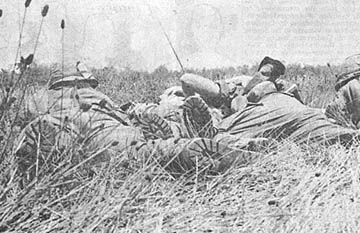 |
Evidence Shows Female VC Working in War Zone C
As elements of the 3rd Bde., 4th Inf. Div. sweep through, clearing the
northern areas of War Zone C, more and more of the larger VC base camps and
supply dumps are being unearthed. Believed to be a sizable complex of the COSVN
headquarters, these camps have furnished good-sized caches of ammunition, new
tools and a variety of products vital to the Viet Cong war efforts.
The larger base camps apparently house a permanent element of an organized
female auxiliary, most likely a seamstress team used to make and repair VC
uniforms. Chinese manufactured sewing machines and even an old model American
sewing machine have been found in excellent working condition.
In past search and destroy missions, there has been evidence that there was
an occasional woman present in the base camp from items of clothing and personal
items left behind.
More recently uncovered camps have produced larger quantities of female
pajama-type garments, new unworn pink and blue cotton sweaters, and
undergarments. Searchers have found among the abandoned clothing, long lengths
of hair that is worn as western women wear wiglets, to make fake "pony tail"
hairstyles and natural hair appear longer.
VC's Rock Mine Uncovered By Sandbag Fillers
Filling sandbags can be a dirty and tiring job, but for the men of the 1st Bn.,
27th Inf., "Wolfhounds" it paid big dividends during a recent operation
southwest of Cu Chi.
The 25th Inf. Div. soldiers were filling sandbags to reinforce a defensive
position. "I was digging and I hit a piece of commo wire," said Sp4 Joseph
Holland of Kuttawa, Ky.
Holland and the three men working with him followed the wire. It went from
their digging position to the center of the battalion's helicopter resupply pad.
"We dug down and found a pile of stones and rocks," said Holland. Under the
rocks was a large Viet Cong mine. Once detonated, the mine would have filled
the air with rock-shrapnel.
The giant Viet Cong fragment mine was destroyed and the men returned to their
job, this time finding it a little more interesting.
| Okay Fans! The "Tropic Lightning News" readership has reached its peak according, to one of our correspondents recently returned from Op. "Waialua." While searching a suspected enemy hootch, he found a page of the TLN wrapped in a plastic bag filled with documents and hidden in a crack between the roof and wall. |
VC's Finest Regiment Falls to US
A decisive victory for the 3rd Bde., 4th Inf. Div. in the battle of Suoi Tre
caused the defeat of one of the finest Viet Cong regiments.
The March 21 battle found the tough 272nd Main Force Viet Cong Regiment
throwing five battalions of enemy soldiers at the forward element of the 3rd
Brigade participating in Operation "Junction City" - they never made it.
Ever since the brigade established its base camp near the tiny hamlet of Dau
Tieng, the 272nd has been under constant surveillance. On nearly every
operation the infantrymen took part in, evidence of the regiment's presence was
found.
The enemy unit was one of the Viet Cong's best-organized and equipped
regiments in South Vietnam. Its morale was exceptional and its fighting ability
was worthy of high praise. Their fire power consisted of scores of recoilless
weapons plus great quantities of automatic rifles. One mark of distinction was
the fact that the regiment would attack in daylight as well as after dark. One
fault of the 272nd Regt. was that it severely underestimated the guts of the
American soldier.
Engagement of the 272nd Regt. was one objective of the 3rd Brigade. It was
hoped that large scale contact would occur, rather than the sporadic contact of
the past.
During the recent Guam Conference the Viet Cong wanted and needed a large
scale victory. The 272nd Regt. and attached forces were sure they could score a
major conquest against the Americans. The massive attack was well planned and
carefully prepared, and as captured documents later showed, it was to bring hope
to the Viet Cong objective, but it proved to be a vain attempt.
Their offensive brought them to the 3rd Brigade and accounted for about one
half of the their unit being destroyed.
The 3rd Brigade had never really participated in a large battle, but when the
VC regiment hit the American perimeter the 4th Div. proved itself as a fighting
unit.
Page 2 TROPIC LIGHTNING NEWS April 10, 1967
Decorated
| BRONZE STAR MEDAL | |
|
Maj. Glen W. Emery, HHD, 25th Avn. Bn. Maj. James R. Vance, HHD, 25th Avn. Bn. Maj. George J. Young,. HHD, 25th Avn. Bn. |
SSgt. R. C. Perry Jr., Co. C, 2nd Bn. (Mech), 22nd Inf. (Posthumously) Sp4 David T. Bell, Co. A, 65th Engr. Bn. (Posthumously) Sp4 Larry P. Blackman, Trp. D, 3rd Sqdn., 4th Cav. (Posthumously) Sp4 Gerald J. Breen, Co. B, 1st Bn. (Mech), 5th Inf. (Posthumously) |
| AIR MEDAL |
|
|
Lt. Col. William S. Kittrell, HHC, 25th S&T Bn. 1st Lt. David F. Arizu, HH&S, 7th Bn., 11th Arty. 1st Lt. Cecil W. Davison, Co. E, 725th Maint. Bn. 1st Lt. Harold K. Graves Jr., HHC, 25th Inf. Div. |
CWO Boyce W. Allen Jr., Co. E, 725th Maint. Bn. SFC William B. Perry, Co. E, 725th Maint. Bn. Sp4 William Rivera, Co. A, 25th Avn. Bn. |
| ARMY COMMENDATION MEDAL |
|
|
SFC Stnley F. Biga, HHC, 1st Bde. SSgt Lyle L. Brown, HHC, 2nd Bn., 14th Inf. SSgt. Charles E. Christian, HHC, 2nd Bn., 14th Inf. SSgt. Richard Trevine, HHC, 2nd Bn., 14th Inf. SSgt. Robert L. Williams, HHC, 2nd Bn., 14th Inf. Sgt. Michael Deforrest, Btry. A, 7th Bn., 11th Arty. Sp5 Jackie F. Anspach, HHC, 25th Inf. Div. Sp5 Omar W. Espeseth, HHC, 2nd Bn., 14th Inf. Sp5 Wilford C. Horab, HHC, 2nd Bn., 14th Inf. Sp5 Shavarsh M. Keuilian, HHC, 2nd Bn., 14th Inf. Sp5 Robert H. Vordtriede, Btry. A, 7th Bn., 14th Inf. |
Cpl. Melvin O. Blake, Btry. A, 7th Bn., 11th Arty. Sp4 Jesus D. Campos, HHC, 2nd Bn., 14th Inf. Sp4 Mark R. Cohen, HHC, 2nd Bn., 14th Inf. Sp4 Bobby G. Evans, HHC, 2nd Bn, 14th Inf. Sp4 Richard H. Gaffney,-HHC, 2nd Bn., 14th Inf. Sp4 David J. Helmbrecht, Co.; B, 2nd Bn., 14th Inf. Sp4 George T. Hill, HHC, 2nd Bn., 14th Inf. Sp4 Archie P. Hoke, Co. B, 2nd Bn., 14th Inf. Sp4 Terry Hunter, Co. B, 2nd Bn., 14th Inf. Sp4 Galvin A. Ingram, HHC, 2nd Bn., 14th Inf. |
|
PURPLE HEART |
|
|
Sgt. Harry L. Harp, Co. B, 4th Bn. (Mech), 23rd Inf. Sp4 Lewis E. Durbin, Co. B, 4th Bn. Mech), 23rd Inf. Sp4 Philip V. Pierorazio, Co. C, 4th Bn. (Mech), 23rd Inf. |
PFC Angelo M. Carrion, Co. A, 1st Bn. (Mech), 5th Inf. PFC Edward T. Dempsey, Co. B, 4th Bn. (Mech), 23rd Inf. PVT. Douglas H. Ketchum, Co. B, 4th Bn. (Mech), 23rd Inf. |
Editorial
Don't Take It for Granted
As members of the Armed Forces, often assigned to duty in a foreign country,
we may be called upon to explain American democracy.
This is a difficult job sometimes, inasmuch as it is hard to define an
ideal. It is particularly difficult when we must put our definition into terms
that have meaning to a person who has never experienced the freedoms and
opportunities we take for granted.
Democracy is not limited to the United States. In various parts of the world
it has developed in different ways. There are, however, certain basic ideals of
democracy, common to all its areas, which inspire and mark it as a unique way of
life.
In a democracy, the basic equality of men is recognized and the individual is
valued more than the state. A democratic government is based upon the rule of
law rather than upon the rule of men and the government is the servant of the
people, not their master.
Reason and experience guide the democratic government, keeping it vital and
flexible. And, although the will of the majority is the governing, the rights
of the minority are not infringed upon.
Following these basic precepts, democratic means and procedures, rather than
force and coercion, are employed to gain social, political and economic goals.
These are our basic democratic ideals. Each of us has, or should have, an
understanding of them and their application and relationship in our individual
lives. Unless we are able to offer tangible definitions of them, we can never
hope to explain them to people of another country.
As members of the Armed Forces, we must be secure in our own knowledge of the
democratic principles which we defend. By our individual actions we serve as an
example to millions of people in the world. (AFNB)
Village and Hamlet Vote to Assure RVN Representative Government
With forthcoming village and hamlet elections, the Republic of Vietnam will
take an important step toward the development of representative government in
the countryside.
The spring elections will restore self-government at the local level. Key
administrative officials of villages and hamlets will be elected. Among them
will be hamlet chiefs, deputy chiefs and members of the village councils. The
village chiefs will be elected by the village councils from among their number.
The first of five consecutive Sunday, village elections was held April 2, the
second yesterday. The hamlet elections will begin on May 14, and run for five
Sundays.
The coming elections flow directly from the commitment to the evolution of
representative institutions undertaken by the Government of Vietnam at the
Manila Summit Conference last October. During the conference, the Vietnamese
representative stated that "the democratic process must be strengthened at the
local as well as the national level." It was also announced that "GVN will
begin holding village and hamlet elections at the beginning of 1967."
The spring elections are an on-schedule fulfillment of that self-imposed
imposed commitment. They will strengthen the support and influence of the
forces committed to representative government.
The significance of the village and hamlet elections looms greater when one
considers that the Vietnamese people have struggled bravely toward the
principles of self-government and independence for centuries. The immensity of
building a nation while at war is staggering. The Vietnamese are making a
gallant effort.
All echelons of government in the Republic of Vietnam have demonstrated on
two occasions - the provincial elections of May 1965 and the Constitutional
Assembly election of last September - their capability for insuring an honest,
secret and effective choice of peoples' representatives. The coming
presidential elections - expected later this year after adoption of the
constitution - will provide yet another step in the evolution of representative
government.
The forthcoming village and hamlet elections further manifest the GVN
commitment to serve the best interest of the Vietnamese people by granting power
to elected and responsible leadership. The spring balloting can play a major
role in winning popular support for the Revolutionary Development Program by
giving the people's elected representatives the main voice in their own local
affairs.
The elections and the local improvements resulting will provide an attractive
alternative to the false promises of the Viet Cong.
DOD Clarifies Retirement Grades
Defense Department has combined and submitted to Congress legislation that
will do away with Army and Air Force "hip pocket" promotions and will allow "top
active duty rank" retirements held in any armed service.
The DOD sponsored bill molds into a single piece of legislation the two
differing provisions - "hip pocket" and "top rank" - which have been submitted
separately to Congress in the past and have failed to gain passage.
The full-time proposal would rule out full-time active duty members from
retiring for non-disability reasons, in a grade higher than which they served
"satisfactorily" on active duty for at least six months.
The top-rank retirement plan would apply to personnel who have served in more
than one service. They would be entitled to retire in the highest grade held
"satisfactorily" for six months or in any service.
Basically, the top-rank plan creates retirement entitlements on the same
basis as if combined service had been in one armed service.
The "hip-pocket" portion dates back to a report made last March to Congress
by the Cabinet Committee on Federal Staff Retirement Systems.
"Nondisability retirement in a commissioned grade from full time active duty
should normally entitle the member to retired pay in the highest grade in which
he served on active duty satisfactorily for not less than six months," the
Cabinet Committee recommended. DOD said it shared this view.
But both the Cabinet Committee and DOD recognize that many officers - largely
Army and Air Force career reserve officers with higher permanent than temporary
rank - planned their careers with knowledge of reserve grade entitlements and
deserve protection.
"Transitional provisions should protect entitlements already earned, but the
privilege thus preserved for an active duty reserved officer based on his higher
permanent grade should not survive a subsequent promotion," the Cabinet
Committee recommended.
On this same point, DOD said, "an appropriate savings clause has been
incorporated in the attached proposed legislation which would protect
entitlements already earned."
February VN Bombing Nears WWII Mark
Bomb tonnage dropped in North and South Vietnam during the month of February
- 68,000 tons is about four times the peak month of the Korean War tonnage.
According to U.S. officials, it approached the peak months of World War II
total weight in the European theater - 80,000 tons per month from all sources,
heavy and light bombers, including fighter planes.
The TROPIC LIGHTNING NEWS is an authorized publication of the 25th Infantry Division. It is published weekly for all division units in the Republic of Vietnam by the Information Office, 25th Infantry Division, APO San Francisco 96225. Army News Features, Army Photo Features, Armed Forces Press Service and Armed Forces News Bureau material are used. Views and opinions expressed are not necessarily those of the Department of the Army. Printed in Tokyo, Japan, by Pacific Stars and Stripes.
Maj.Gen. John C. F. Tillson III . . . . Commanding General
Maj. Bernard S. Rhees . . . . . . . . . . . Information Officer
Capt. John P. Fortner . . . . . . . . . . . . Officer-in-Charge
Sp4 Adrian E. Wecer . . . . . . . . . . . . Editor
Sp4 John R. Dittmann. . . . . . . . . . . . Editorial Assistant
Page 3 TROPIC LIGHTNING NEWS April 10, 1967
Jungle Saves Trooper From VC at Soui Da
A 3rd Bde., 4th Inf. Div. trooper sat "on the outside looking in" when the
272nd Main Force, (VC) Regiment tried to overrun the brigade's forward element
participating in Operation "Junction City."
Sp4 David F. Hodges of Mineral, Va., was the only man of a 12-man patrol not
killed or injured during the fierce battle.
Hodges, a member of the 3rd Plt., Co. B, 3rd Bn., 22nd Inf., was situated
outside the perimeter when "human wave" attacks started. His platoon
immediately took casualties and the situation looked hopeless as the screaming
Viet Cong came charging in.
"Four of the guys told the rest of us to get out of there and pull back."
Hodges said quietly. "Seven of us tried to move back to the camp's perimeter,
but the firing was real bad and we had to take cover behind a few mounds of dirt
instead."
The seven men, with Hodges the only man not wounded, were behind thick jungle
cover and most of the Viet Cong didn't bother with them. Capt. Walter Shugart,
Co. B commander, commented that the enemy was more interested in overrunning the
base camp and weren't worried about isolated pockets.
"A whole pile of VC were coming down a trail right at us, but went to the
right or left when they got to our front. Finally a guy - I think he was a
medic because he carried a bag and no weapon - ran off and brought back four
buddies to take care of us."
Hodges was the only man able to fight. He raised his M-79 grenade launcher,
fired one of his three remaining rounds, and killed the advancing Viet Cong.
"Even after that they still kept coming down the trail," he said, "but they
never bothered us."
The battle raged on for five more hours and the patrol members sweated it
out. They could see Viet Cong getting hit, falling back for bandages, and
charging into the camp's perimeter again. Hodges could see Viet Cong all around
him, but still they left the stranded Americans alone.
Friendly artillery, firing with tubes lowered for point blank range, tore
gigantic holes in the Viet Cong ranks. Shrapnel whizzed past the wounded
Americans, but Hodges still remained unscathed.
When reinforcements finally arrived an armored personnel carrier from the 2nd
Bn., 22nd Inf., found the Americans and carried back the wounded.
"I was sure glad to get back." Hodges said smiling. The four men who
volunteered to stay behind to save their buddies were overrun and killed.
Westy Calls 4th Div. Fight Major Victory
Gen. William C. Westmoreland climbed on the hood of the jeep and stared at
the men of the 3rd Bde., 4th Inf. Div. who just hours before had killed 635 Viet
Cong during an attack on the brigade's forward base camp during Operation
"Junction City."
"This battle," the general said, as he squinted into the harsh sun, "is a
major victory of the Vietnam war."
He explained the main reason for the gigantic battle and the effect it had on
the Viet Cong morale.
"I was out of the country at the time (the general was visiting President
Johnson on Guam) and the Viet Cong felt it was a good time to win a large
victory and build up their morale. They wanted and needed a victory," he said.
Every man in the forward camp was engaged in the fight - many in vicious
hand-to-hand battles.
"It's rare," Gen. Westmoreland said as he scanned the battlefield, "that an
artilleryman has to fight like an infantryman, but you men (the 2nd Bn., 77th
Arty) did an excellent job."
McCormick's Raiders
'Clerks, Cooks, Candlestick Makers'
By Sp4 Larry Craig
Cooks, mechanics and clerks have taken up arms at Hq. Trp. of the 3rd Sqdn.,
4th Cav., in a newly formed voluntary organization called "McCormick's Raiders."
Knowing their supportive roles were essential to the carrying on of the war
was not enough to keep up their morale under the circumstances. In January the
troop got a new commander who gave the men a tremendous boost in spirits. He is
Capt. John R. McCormick of Corpus Christi, Tex.
He spent the first six months of his tour behind a desk, but as a
professional soldier trained in the combat arms, he felt he would be more
effective in Vietnam in a combat unit, so he volunteered for reassignment to the
"Tropic Lightning" division.
His assignment to headquarters troop was not quite what he was looking for
but he soon found that he was not alone in his desire to go where the action is.
Many of the men of the troop had originally volunteered to come to Vietnam
hoping to fight the Viet Cong in the jungles and rice paddies and after six or
eight months of changing oil, typing disposition forms and frying eggs they were
becoming rather bored.
Contrary to the ideas of the line troopers, they were not "pansies." To
prevent the exodus of a lot of good men to combat units, McCormick came up with
a compromise that they found to their liking.
The proposal was to form an operational volunteer unit which would go on
patrols and ambushes in relief of the often overworked line troops - 25 men
volunteered.
For seven days straight they underwent intensive training in mines, booby
traps, anti-guerrilla tactics, map reading, communications, practice patrols
inside the perimeter and physical training every morning at reveille. All this
was done in addition to their regular duties.
Two weeks ago they went on a daylight rehearsal to an area south of their Cu
Chi base camp. The squadron commander was then told that McCormicks' Raiders
were operational.
They were recently sent on their first mission which was a night patrol.
Sgt. Robert Bellrose of Maspeth, N.Y., radar section leader for headquarters
troop was one of the members of the patrol. He has been in Vietnam for ten
months and had spent all his time in support work after volunteering for duty in
Vietnam with "High hopes for a combat unit."
He had requested reassignment to a line unit but now that he is a member of
McCormick's Raiders he is quite content to stay where he is.
That first patrol was quite successful. They found the enemy; an estimated
VC squad, engaged him and came back to base camp without a casualty.
The famous "McKenzie's Raiders" of the 3/4 Cav. in its early history gave the
men of headquarters troop the idea for their own name, McCormick's Raiders,
after their own leader, Capt. McCormick.
| Volunteers who compose the "McCormick's Raiders", leave the 25th Inf. Div. base camp for a night patrol in the rubber plantation south of the camp. (Photo by: Sp4 Larry Craig) |
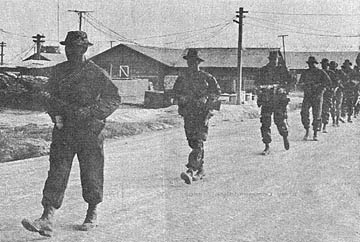 |
'Cacti Blue' Men Kill 61 NVA On Operation 'Sam Houston'
The 2nd Bn., 35th Inf., "Cacti Blue," under the operational control of the
4th Inf. Div., encountered two North Vietnamese Army (NVA) battalions west of
the Se San River near Plei Djereng, while participating in Operation "Sam
Houston."
Their action was the second major contact made by elements of the 3rd Bde.
Task Force in the last two weeks.
The incident occurred when Co. A of the Cacti Blue battalion left their base
camp on a southwestern course to investigate a recent B-52 air strike.
About 9:30 a.m. the 1st Plt. made contact with NVA snipers hiding in trees
and fortified bunkers. They shot one NVA and in turn were pinned down by
automatic weapon fire from the bunker position. The 3rd Plt. maneuvered left
and also made contact, but was not able to penetrate the enemy defense.
Artillery was called in by Co. A, but it remained pinned down by the NVA.
Two other companies were helilifted to nearby landing zones in order to
assist the besieged company. At 10:30 p.m. contact with the enemy began to
dwindle and artillery fire was called in once again to block their retreating
movement.
The next morning Co. A conducted a sweep of the NVA base camp and Capt. Luis
Barcena, company commander, found that the NVA had managed to escape during the
night. A search of the battlefield yielded a total of 61 enemy bodies, numerous
small arms and assorted equipment.
The extensive bunker system uncovered by the Cacti Blue was actually
interlocking base camps with handrails connecting the bunkers so the NVA could
move from one bunker to the other without straying outside the perimeter.
Col. Clinton E. Granger, battalion commander, who was on the ground through
most of the fighting said afterward: "The 18-hour battle took place in some of
the roughest jungle terrain in Vietnam and was characterized by vicious close
fighting. All the men - infantry, artillery and gun ships - did a terrific
job."
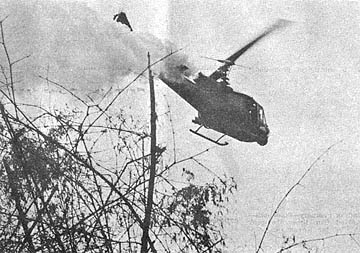 |
"Smokey the Bear", a specially equipped mosquito spraying helicopter blankets the forward base camp of the 2nd Bde. Officials in charge of the operation claim a 3,000,000 body count with an additional 47,000,000 possibles. The action took place as part of Operation "Waialua" southwest of Cu Chi. |
Page 4-5 TROPIC LIGHTNING NEWS April 10, 1967
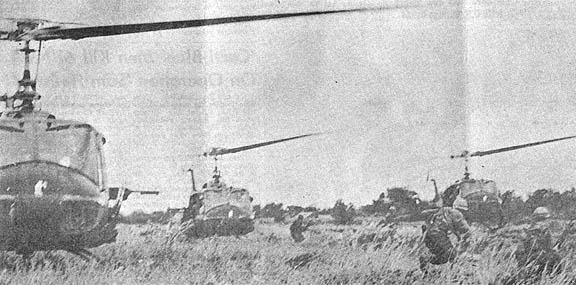 |
| COMBAT ASSAULT - "Little Bear" Hueys from the 25th Inf. Div. drop troops for a combat assault mission. Men of the 2nd Bn., 27th Inf. Wolfhounds charge from the helicopter to flush out the Viet Cong. |
In The Air And on The Ground
S&T on Operation 'Junction City'
| COMBINED EFFORT - Air Force transports carry men of the 25th Inf. Div. to War Zone "C" during Operation "Junction City." The C-123 aircraft took the men to Tay Ninh where they departed for the jungle area. |
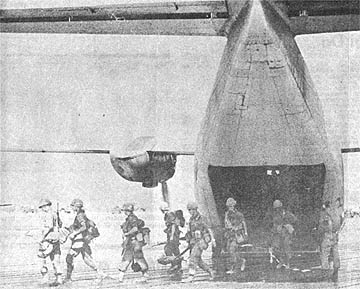 |
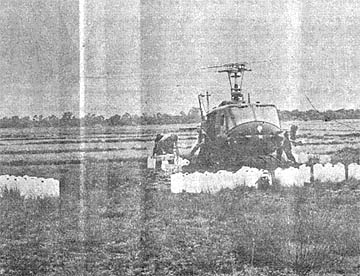 |
RESUPPLY - Choppers in Vietnam bring in tons of food and fresh water. Men of the 4th Bn. (Mech ), 23rd Inf., 25th Inf. Div., swiftly unload a Huey from Cu Chi. |
| DISCONNECT - De-riggers jump in following the air drop of supplies and quickly disconnect the cargo from its chute and unpack it for distribution to units. |
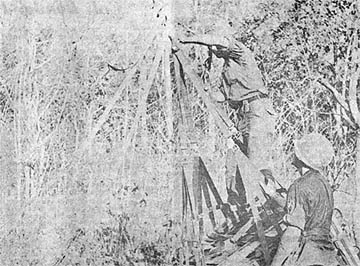 |
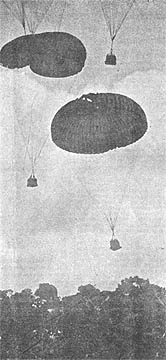 |
PARADROP - Tons of supplies are dropped into the support bases in the jungle area near the Cambodian border. The supplies were dropped to the fighting troops of the 25th Inf. Div., 196th Lt. Inf. Bde., 3rd Bde., 4th Inf. Div., 173rd Abn. Bde. and the 1st Inf. Div. |
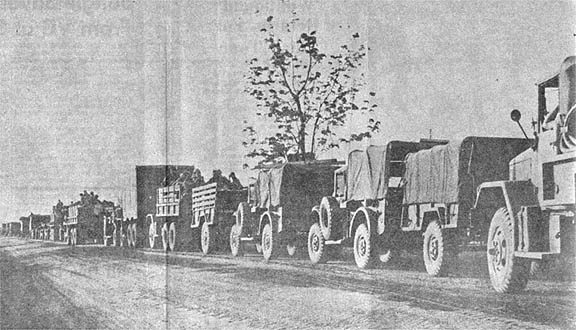 |
| MOVE OUT - A massive convoy of some 1600 vehicles accounts for one of the largest land movements of the Vietnamese war when men and supplies are moved into the Tay Ninh Province for Operation "Junction City." |
Page 6 TROPIC LIGHTNING NEWS April 10, 1967
MEDCAP at Vinh Cu: Real Achievements
Doctors and medics of the 25th Division's 1st Brigade are presently
witnessing what is believed to be the second successful phase of the Medical
Civic Action Program (MEDCAP).
For the first time since the division began carrying out its MEDCAPs in the
Vinh Cu area, have Vietnamese citizens volunteered to aid the "Tropic Lightning"
doctors and medics in their health-restoring chores.
Vinh Cu, a hamlet of some 500 inhabitants, was cleared of the Viet Cong in
early May of 1966, when 25th Inf. Div. troops extended the perimeter of their
base camp to the border of the former VC stronghold. After several skirmishes,
the enemy vanished and the road was paved for the first medical team to enter
the limits of the tiny hamlet.
Since, the MEDCAP teams have treated nearly 400 patients a week at Vinh Cu
and the general health of the entire population has been considerably improved.
The attitude of the people towards the division has also improved, from one of
complete distrust to one of true congeniality.
During the last month, six young ladies have volunteered to aid in the
growing medical program in their village. Their present duties only include
such tasks as treating minor cuts and rashes, and the applying of bandages, but
plans for giving these volunteers further medical instruction are now under
consideration, so that in the days to come, when the division may no longer be
in the area, the people of Vinh Cu can take care of themselves.
"We have beaten the enemy on many fronts here," commented Maj. Joseph Devins,
the 1st Brigade Civic Action Officer, "but now, with this achievement, I really
feel we are doing our job."
"The day that first young lady rolled up her sleeves and started working with
our medics was, to me, the day we really started to win this war."
Gen. Palmer New II-FFV Boss
Lt. Gen. Jonathan O. Seaman recently presented the II FFORCEV colors to Lt.
Gen. Bruce Palmer Jr., newly assigned commanding general of the command. Gen.
Palmer was formerly the Commanding General of the XVIII Airborne Corps, Fort
Bragg, N.C.
Heading the list of distinguished visitors at the ceremony was Gen. W. C.
Westmoreland, commanding general, U.S. Military Assistance Command. Gen.
Westmoreland decorated Gen. Seaman with the Silver Star.
Other guests included Lt. Gen. John A. Heintges, deputy commanding general,
U.S. Military Assistance Command, and other high ranking officers of Gen.
Seaman's former command and Free World Forces.
Gen. Seaman, whose next assignment is as a special consultant in the Office
of the Chief of Staff of the Army, came to command II FFORCEV on March 15, 1966
after having commanded the 1st Inf. Div. in Vietnam since September 1965.
The "Big Red One," now commanded by Maj. Gen. John Hay, is currently under
operational control of II FFORCEV, as are these other units: II FFORCEV
Artillery, commanded by Brig. Gen. W.D. Crittenberger Jr.; 9th Inf. Div.,
commanded by Maj. Gen. George S. Eckhardt; 25th Inf. Div., commanded by Maj.
Gen. John C.F. Tillson III; 173rd Abn. Bde., commanded by Brig. Gen. John R.
Deane Jr.; 196th Lt. Inf. Bde., commanded by Brig. Gen. Richard T. Knowles,
199th Lt. Inf. Bde., commanded by Brig. Gen. John F. Freund; 1st Australian Task
Force, commanded by Brig. Stuart C. Graham, OBE, MC; 3rd Bde., 4th Inf. Div.,
commanded by Col. Marshall B. Garth; 11th Armored Cav. Regt., commanded by .
Col. William W. Cobb; 23rd Arty. Gp., commanded by Col. Thomas H. Sayes; 54th
Arty. Gp., commanded by Col. Charles M. Mizell; 12th Avn. Gp., commanded by Col.
Raymond P. Campbell Jr.; and the 2nd Bn., 34th Armor, commanded by Lt. Col.
Raymond L. Staily.
II FFORCEV directs these units in operations against the Viet Cong within the
III Corps Tactical Zone and in Dong Tam area near My Tho.
Major operations of II FFORCEV and its units in the past year include
Birmingham, Toledo, Lanikai, Enterprise, Attleboro, Cedar Halls, and Junction
City.
Gen. Seaman, in speaking of his command, was unstinting in his praise of the
units and men .of II FFORCEV, pointing out their high professional caliber and
sense of dedication.
His high praise for the combat soldier on the field of battle is particularly
noteworthy. In turn, observing the soldierly pride on the faces of the men in
the formation during the ceremony and hearing the comments of those in
attendance, it is not hard to find praise for the accomplishments of Gen.
Seaman.
Gen. Seaman further spoke of his regard for the people of South Vietnam and
of the importance of II FFORCEV support of Revolutionary Development, a massive
civic action program to help the people of South Vietnam lead a better life
without fear of reprisal by the Viet Cong.
Gen. Seaman's wife and two daughters now reside in Junction City, Kansas just
outside Fort Riley.
'Wolfhound' Returns For Third Tour
Three combat tours completed with the 27th Infantry "Wolfhounds" and he is
coming back for more. That is SSgt. Kenneth D. Black of El Paso, Tex.
His first tour was with "King" Company, 3rd Bn., 27th Inf., for eleven months
in Korea in 1950. He then rejoined them in 1952 at "Heartbreak Ridge," in
Korea's Iron Triangle. Since last April, Sgt. Black has been serving with Co. A
of the division's 1st Bn., 27th Inf., "Wolfhounds."
Sgt. Black has had a busy year here taking part in many operations such as
"Attleboro" and "Junction City." He has won two Purple Hearts and on his last
two days in the field before returning to prepare to go on leave, he accounted
for two kills.
The first was in action near an old French fort in the vicinity of Duc Hoa,
about twenty five kilometers west of Saigon. Two platoons of Co. A were moving
into an ambush position when Sgt. Black received word that movement had been
noticed to the rear of his platoon.
He moved to the rear himself and found that approximately 12 Viet Cong had
been spotted. He saw at least four himself. As he lay scanning the area in the
moonlight he saw one of the enemy about 30 meters away crouched down and edging
toward the platoon. Sgt. Black waited until he was about 12 feet away and then
stopped him cold with a shotgun blast.
The next action took place the next evening when Co. A was moving thru dense
underbrush into their night's position along the Oriental River, about eight
kilometers west of Duc Hoa. Candlelight was noticed in a bunker and Sgt. Black
along with two others moved in on the bunker. A hand grenade was thrown in and
Sgt. Black again fired his shotgun. The next day a trail of blood was found
leading from the bunker to the river bank where a Viet Cong lay dead from a
shotgun blast.
Admin Company 1st. Lt. Learns The Hard Way
1st Lt. Peter Bartling believes that an officer should have a firm idea of
how the men in his command live so they can be supervised accordingly.
To further understand how his men feel after pulling guard duty, the
24-year-old Personnel Management Officer with the division's Admin. Co. pulled a
guard detail with his men.
"I could never appreciate how my men feel the day after they were on guard.
I didn't know what time to release them from work to prepare for the guard mount
and how much rest they need the following day," said Lt. Bartling of Omaha, Neb.
Last week, Bartling asked the Admin. Co. commander if he could go on guard
duty with his men and permission was granted. The lieutenant reported to the
company orderly room with the rest of the guards a few days ago ready to assume
the responsibility of securing a perimeter.
"When we got to the bunker, the men assumed their designated duties and I
watched. For a while I manned the machine gun and also the M-79 grenade
launcher on the top of the bunker," said Lt. Bartling.
At midnight, I left the bunker and walked the quarter-mile back to my area so
I could absorb the experience. I'm really glad I did because now I have a good
idea of how a man feels the day after guard. I can better appreciate an
enlisted man's problems from the experience. I have more of an idea of how he
lives," he concluded.
Col. Bender Praises Soui Da Defenders
"It was a team show all the way - artillery, air and infantry all worked
together." So describes the biggest battle of "Junction City" by Lt. Col. John
A. Bender, commander of the 3rd Bn., 22nd Inf., the unit that blunted a suicidal
human wave Viet Cong attack near Tay Ninh.
Col. Bender, a West Point graduate with the class of '49, was personally
awarded the Silver Star by Gen. W. C. Westmoreland after the 3rd Bde., 4th Inf.
Div. repulsed an attack by the elite 272nd Main Force Viet Cong Regiment,
killing at last report 635 enemy soldiers.
Presented by Gen. Westmoreland in Saigon at a nightly press conference it was
Bender's second such award during his 24-year Army career.
"The teamwork was the one thing that turned the battle," the colonel said as
he scanned the battle site. "They came in at us on three sides after hitting us
with mortars."
The colonel, sitting bare-chested in the hot afternoon sun, said a number of
mortar and rocket rounds fell into the fire support base - when the VC had
already started their human wave attacks.
His hammock and poncho liner were filled with tiny shrapnel holes. There
wasn't a tree in the area that wasn't marred by bullets, fire or shrapnel. The
four hour battle was one of the most intense the war has seen.
"This was the first big fight these men have engaged in and they were
magnificent. No one shirked his duty," said Col. Bender.
During the battle, Col. Bender was constantly running from his bunker with
rounds falling around him, directing his men into defensive positions, giving
encouragement, keeping platoons and companies from falling back, and making sure
the Viet Cong did not succeed in overrunning the camp.
Relaxed with a cigarette in his hand the colonel scanned the camp with a
clear, concise stare. "The men were magnificent," he said.
Grenade Laden Artilleryman Turns 'Grunt' on Battlefield
Sgt. James W. Evans of Buffalo, N.Y. was working as a gunner for the 2nd Bn.,
77th Arty., when the biggest battle of the Vietnam war started during Operation
"Junction City."
The forward base camp of the 3rd Bde. was hit in the early morning hours by
the tough 272nd Main Force. (Viet Cong) Regiment with a full scale attack.
Mortars were falling everywhere and enemy soldiers began coming towards the
American bunkers in screaming human waves.
Evans, a 26-year old gunner from Btry. A was picked to work with a reaction
force to drive the advancing enemy back away from the hard hit perimeter. His
M-14 jammed and Evans had to work the bolt by hand as he fired into the
on-rushing ranks of Viet Cong.
Co. B of the 3rd Bn., 22nd Inf., was forced to pull back, but Evans grabbed a
sandbag full of hand grenades, placed the bag between his teeth, grabbed a
grenade with each hand and started killing Viet Cong within five meters of his
position.
Evans ran forward, again with the sandbag clenched between his teeth, and
started throwing more grenades. He held at the new perimeter line until armored
personnel carriers from the 2nd Bn., 22nd Inf. reinforced the Ivymen ending the
six hour battle.
Page 7 TROPIC LIGHTNING NEWS April 10, 1967
Aviation Battalion Undergoes Big Change in Personnel
In the past two weeks, the division's 25th Avn. Bn. has undergone a complete
personnel change in all of the key positions save one - The battalion
commander. The battalion consists of an airmobile company: the famed "Little
Bears," and a general support company: the armed "Diamondheads." Working as an
inseparable team, the two companies provide varied and timely aviation support
to the men of the "Tropic Lightning" through combat assaults, aero-medical
evacuation, aerial resupply, airborne command and control, convoy cover, target
acquisition and attack, and a host of other aviation support missions.
The new commander of Co. A, 25th Avn. Bn., "Little Bears" is Maj. Charles J.
Brown of Easton, Penn. He was assigned to Vietnam and the division from Rhode
Island where he last served as advisor to the National Guard. This is Maj.
Brown's second tour in the Republic; his first was with the 114th Airmobile Co.
at Vinh Long in 1964-65. Maj. Brown has participated in several combat assaults
with his new company, both from the lead ship and the command and control
helicopter.
Maj. Jack Hill assumed command of Co. B, 25th Avn. Bn. "Diamondheads" and is
already flying his armed Huey in escort for the Little Bears as well as in
general support of the division.
The battalion staff has also undergone a complete revision of personnel: The
new executive officer, Maj. Bill Watson, is serving his second tour in Vietnam.
His last assignment was with Seventh Army in Germany. Maj. Pete McGurl is the
new S-3 and come from the Infantry Center at Ft. Benning, Ga. Capt. Dexter
Baxley, S-1, is a former armed helicopter fire team leader and was recruited
from the Diamondheads. Capt. Pete Barrett (S-2) and Capt. John Pirkle were both
previously assigned to the Little Bears as flight section leaders.
196th Doctor Cures Girl's Eye Defect
"A cuter little girl I've never seen, but her eyes were like two pools of
muddy water."
These were the words of 1st Lt. (Doctor) John Gilkey of Memphis, Tenn.,
executive officer of the 196th Lt. Inf. Bde's Co. C, 8th Spt. Bn., when, on a
visit to a Vietnamese village near Tay Ninh city, he met Chi, a seven-year-old
Vietnamese girl whose eyes bore permanent scarring from smallpox.
Lt. Gilkey, himself the father of a seven-year-old girl, decided to do
something about Chi's plight. Contact was made with the ophthalmologist at the
Army's III Field Hospital in Saigon. Soon the lieutenant was en route to the
Vietnamese capital with her, for corrective surgery.
"The permanent scarring could not be corrected," Lt. Gilkey explained, "but
there is still hope for improving her fast-fading eyesight. The operation
consisted of making a slit on the upper edge of the cornea of the right eye,
permitting more light to enter."
The operation was only the first step to help Chi in her fight against
eventual blindness. Over a period of weeks, an exhausting series of eye
exercises were administered to teach her to use the corrected right eye and
reduce the strain on her overworked left eye. Medics from the battalion's Co. C
which operates the brigade dispensary, made three visits weekly to her village
to assist in the postoperative exercises.
Now, six weeks after Lt. Gilkey's initial contact with Chi, and after three
trips to Saigon and many post-operative visits to her village, she is able to
see images clearly that had previously been a blur.
PFC Awarded Bronze Star
A wounded man who risked his life to retrieve two valuable weapons during
Operation "Cedar Falls" has been awarded the Bronze Star Medal.
PFC Earl B. Dewalt of Washington, D. C., assigned to Co. C, 2nd Bn., 1st
Inf., 196th Lt. Inf. Bde., was on a search and destroy mission when his platoon
came under fire from fortified enemy bunkers. PFC Dewalt was wounded but
continued to return fire.
The platoon withdrew to make way for an artillery strike, inadvertently
leaving behind a claymore mine and a rifle. Despite continuing fire, PFC Dewalt
moved toward enemy positions and retrieved the weapons.
196th Oilers: 'Stronger Than Dirt'
While not all of Vietnam is "hot and dry, or hot and wet,' the merciless sun
during the dry season bakes the ground of Tay Ninh Province. Construction work
and convoy traffic raise huge clouds cf choking, gritty dust, which add to the
miseries of the dry season.
To control this powdery grit, the service section of Co. B, 8th Spt. Bn., has
modified three 2 1/2-ton trucks as oil spreaders, or "oilers." Spreading an
even coat of absorbing black oil over what was once inches of loose brown dust,
the oilers traverse the main roads of the brigade's base camp, proving
themselves "stronger than dirt."
The trucks, converted into oilers by men of the service section, were
designed by Sp4 Claude Wiley of Caracpolis, Pa., and Sp5 Thomas W. Lloyd of
Roanoke Rapids, N.C. Each oiler is equipped with nine 55-gallon oil drums,
giving it a capacity of about 500 gallons.
The first attempt in design produced a 10-barrel pyramid-shaped sprayer.
Repeated breakages in this system demonstrated the need for a sturdier, more
durable arrangement. The result is the oiler now in use. It is fashioned with
nine drums flat on the back cf the truck, joined together with 105mm howitzer
ammunition cannisters.
While this design has proven rugged, great care must still be taken to avoid
damage which could cause a leak. If a leak in the tanks does occur, repairing
it is a long and sometimes dangerous process. The drums must be completely
drained of fuel and washed out with water. Because the fumes remaining in the
barrels could cause an explosion when repair work with the blowtorch is being
done, exhaust from the truck must be blown through the barrels to expel the
fumes. This process alone takes four to five hours.
| ON THE WAY, WAIT - A big gun of the 3d Bn., 13th Arty., fires in support of "Tropic Lightning" troops during Operation "Waialua." The operation is presently being conducted by units of the division's 2nd Bde. southwest of Cu Chi. | 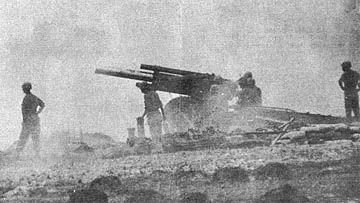 |
Senator Byrd Visits Div. Troops
Senator Harry F. Byrd Jr. (Democrat-Va.) visited the home of the "Tropic
Lightning" division yesterday. The purpose of the senator's visit was to tour
the base camp and meet some of his constituents in uniform.
Senator Byrd was met at the Cu Chi Army Airfield by the Assistant Division
Commander, Col. Robert L. Shaw, who escorted the Senator to 1st Brigade
Headquarters.
At Brigade Headquarters, the Senator was greeted by Col. Francis S. Conaty,
the Brigade commander from Annadale, Va. Col. Conaty then accompanied the
Senator to a luncheon held in his honor at the 2nd Bn., 14th Inf. area.
Before the meal, Senator Byrd met more than 20 of his fellow Virginians. He
asked them how they were, and promised to relay messages to their families.
With many, he joked and raised their hopes with his stories of home. Everyone
wore smiles as they took their seats for lunch.
After a satisfying meal, Senator Byrd was rushed to the Cu Chi Army Airfield
where a helicopter awaited to take him to the next stop on his tight Vietnam
schedule.
Page 8 TROPIC LIGHTNING NEWS April 10, 1967
Base Fire Department Takes Emergency Call
By Sp4 Richard Calvo
It was the evening of March 15. The 25th Division's base camp lay quietly
awaiting the end of another day. Men took showers after their hot day in the
sun. The dust-filled roads smoked with the blowing of the dry night wind.
In a small hootch near the division airfield, four men sat talking over the
days events. To them it would be a long night; a night filled with fear and
hard work. They were the men of the Cu Chi Fire-Crash Rescue Section.
At 7:35 p.m. Sp5 Clarence R. Rheaune, a Senior Fire Fighter, entered the
dimly-lit hootch and made himself comfortable. Outside, the sun was setting,
and everything turned slowly into shadows. The five men continued their
conversation.
Suddenly at 7:45 p.m. the phone began ringing furiously. Specialist Rheaune
jumped to his feet and grasped the receiver.
"Be on alert . . . the base camp is now under mortar fire!" cried a voice in
the phone.
Hanging up Rheaune alerted his men. "We're being mortared. Get ready!"
The five men scrambled immediately for their equipment. Rubber boots were
thrown on; water proof jackets zipped; and fire helmets secured. The 2 1/2-ton
fire engine stood ready to move at a moments notice with its 400 gallons of fire
extinguisher.
It wasn't long before the phone rang again. Five buildings in the Division
Artillery area were burning. Help was needed-quickly!
The streets were deserted. Everyone had taken shelter from the unpredictable
enemy fire. Choppers flew overhead and flares were being dropped along the base
camp's perimeter. The only vehicles on the road were those of the medics and
that of the fire fighting team.
Around the Cu Chi Airfield, came the fire team with mortar rounds hitting the
very road in which they drove. Flying shrapnel scattered about them, but
miraculously no one was hit.
Less than a minute later, the truck stood in front of the five flaming
hootches. The crew was scurrying across a field with steaming water hoses while
yelling instructions to the curious onlookers. Soon dozens of men were battling
the flames. Enemy mortar rounds were still landing.
Three of the wooden-framed buildings were entirely engulfed in the blaze, and
eventually had to be given up to the fire. The other two were still salvageable
and so all effort was concentrated on them.
Armed with axes, the fire fight team cut away burning portions of bamboo is
order to isolate the flames. A water tanker, supplied by the Supply and
Transportation Battalion, arrived to give assistance. The fight raged on.
An hour went by, and the men were still battling the stubborn fire. Entire
sections of building were now being moved away from the unceasing flames.
Everyone worked tediously with axes, buckets, hoses and straining muscles.
Smoke from smoldering wood filled the air as the second hour of fire
fighting found the original five man crew dowsing the last remnants of the enemy
attack. The fire had been extinguished.
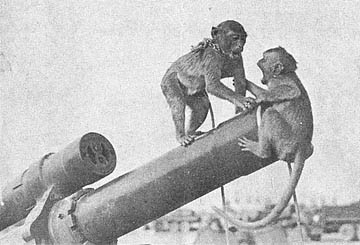 |
Hold Your Fire, Mac! Wait till I get my bananas out of here . . . Two mascots of the 1st Bn., 8th Arty., seem to be in a world of hurt and hurry as men of the artillery unit prepare to fire on Viet Cong positions in support of the 2nd Bde. during Operation "Waialua." (Photo By PFC David Givens) |
For Vietnam Service
Major Evans Receives Legion of Merit
Maj. Herbert C. Evans, 37, Headquarters, United States Army, Hawaii, received
the Legion of Merit recently from Maj. General Roy Lassetter, Jr., Hawaii Army
Commander, for "exceptionally meritorious conduct in the performance of
outstanding services" in Vietnam from December 1965 to December 1966.
Now acting information officer at Schofield, Evans was cited for his work in
Vietnam as Commanding Officer, 3rd Supt. Bn., 3rd Brigade Task Force, 25th Inf.
Div. and later as division Chemical Officer.
A "new" unit in the Army, the support battalion was organized at Schofield
Barracks early in December, 1965, with Evans as the first commander. Him
mission was to organize, train and move the unit from Hawaii to Vietnam.
The 350-man outfit included men from Army Ordnance, Quartermaster, Medical,
Signal and Transportation Corps, clerks and drivers - a miniature of the
division's Support Command. It was formed into a Headquarters, Supply and
Transportation Company, a Medical Company and a Maintenance Company.
The advance party left Hawaii in late December, the entire battalion was in
operation at Pleiku in the Central Highlands of Vietnam in late January. Its
combat mission was to furnish all logistical support to the 3rd Brigade Task
Force of about 4000 men.
"We fixed what was broken, replaced what couldn't be fixed, from watches to
tanks, got and delivered rations and ammunition and everything else they needed,
moving it by armed truck convoy from Qui Nhon on the South China Sea to Pleiku,
or delivering it by Caribou plane or by helicopter, as far as the Cambodian
border," Evans said.
The battalion's ration requirements for the brigade were staggering,
totaling about a quarter of a million meals during the six months that Evans
was in command, with meals ranging from C-rations to turkey. The battalion also
arranged for laundry services and ran a bath unit.
The son of Mrs. Blanche L. Evans of Columbus, Ohio, and the late Robert B.
Evans, Sr., Evans was commissioned in the Army via ROTC after graduation from
Hampton Institute, Hampton, Va., with a degree in chemistry in June 1953, went
on active duty the following September.
A Chemical Corps officer, he has attended courses at the Chemical Corps
School, Ft. McClellan, Ala., Quartermaster School, Ft. Lee, Virginia, and the
Air Force's Air-Ground Operations School, Keesler Air Force Base, Mississippi.
He has been selected for attendance at the Army Command and General Staff
College, Ft. Leavenworth, Kansas, will leave Hawaii in July.
2/12th Finds A Large Cache In Tay Ninh
The largest single cache of VC rice discovered during Operation "Junction
City" was found recently in a base camp near the Cambodian border in Tay Ninh
Province.
Co.'s A and C, 2nd Bn., 12th Inf., uncovered the rice stored in two huge bins
measuring 12 feet by 40 feet and piled ten feet high.
The battalion spent the night in a nearby clearing, and in the morning
conducted a search of the immediate area. Air strikes and artillery from the
previous day thinned cut expanses of the surrounding area and laid bare several
hundred meters of trench work. They also produced a series of well dug-in
bunkers. Traces of fresh blood were found and the deserting occupants of the
base camp left behind a variety of tools and personal items.
In the afternoon, the searchers discovered a larger portico of the same camp
to the southwest of the clearing, linked to the first by well-traveled trails.
It was here, within sight of the river which separates Cambodia from Vietnam,
that the stockpile of rice was found. Again a clearing was near some huts, and
it too was planted with punji stakes - it also possessed four punji man-traps
with three-foot punji stakes in the bottom.
Using dozens of newly made, but unplanted punji stakes for kindling wood and
four 55 gallon barrels of kerosene for fuel, the American soldiers burned the
structures. Engineers made the rice unusable by planting explosives and tear
gas in the piles.
Further investigation of the dwellings, revealed that one of the large ones
contained a second level underground room. It contained ten 5 gallon cans of
printing type, sorted and wrapped in individual packets, but the printing press
was not found.
4th Bn. Engineers Returning After 6-Month Separation
After six months of being separated from their unit, Co. C, 4th Engr. Bn. has
been reunited with the 3rd Bde. 4th Div.
Co. C, commanded by Capt. Carl Scyple moved from the Dragon Mountain base
camp at Pleiku where it had been since its arrival in Vietnam last September, to
join the brigade in Operation "Junction City."
The work of Co. C has produced several very significant changes to War Zone
C. The first platoon, commanded by Lt. Walter H. Petrie, has been doing road
clearing and construction work on route 22 going north from Tay Ninh to Cambodia
and on route 20 going west from route 22 to Lo Go.
Back at Dau Tieng, the 2nd Plt. is constructing a cement "batch" plant which
will efficiently make and distribute large quantities of cement.
'Wolfhound' Men Find Cong Trap At Washing Site
"All we wanted was a chance to wash up in the creek. We didn't figure on a
booby trap to delay us," was the comment of Sp4 Patrick Morrison, 20, of San
Francisco, Calif., in HHC Co. of the 2nd Bn., 27th Inf. "Wolfhounds", after he
and Sp4 Joe Rayburn, 20, of Gibbon, Neb., found a VC booby trap at their washing
site.
They had found the creek after a day of wading through the rice paddies,
southwest of Cu Chi on Operation "Waialua". They had just begun to wash up when
Morrison noticed a trip wire laying only inches from his foot. The grenade
attached to it needed only a slight nudge from the trip wire to go off.
The two specialists cleared the area of personnel and detonated the booby
trap in place.
21st Immunizes Orphanage
The "Guardians" of the 2nd Bn., 1st Inf., have begun a typhoid fever
immunization program at the Co Nhi Vien Orphanage in Tay Ninh. The first
inoculations were given recently to the children and staff of the orphanage.
Most of the children had never had a shot before, and they were naturally
hesitant in coming forward to the man with the needle. After the first few were
administered their shots, however, the fear vanished, and the others came
willingly. Only a few of the smaller children even cried.
2nd Lt. Justin Gottfried of Milwaukee, Wis., assigned to the battalion's aid
station, commented that the battalion has high hopes for the success of the new
program. "At a regular village MEDCAP (Medical Civic Action Program), if you
give immunizations, you run into the problem of rounding up the same people when
it comes time for the booster a few weeks later. It's almost impossible to do
anything that requires a series of treatments," he said. "At the orphanage,
however, the population is relatively stable, and you can expect to find the
same people week after week. This makes it possible to have an effective
immunization program."
The Guardians adopted the orphanage in December, and visit with a MEDCAP team
at least once a week.
Thanks to:
Gary Hartt, 2nd Bn. (Mech.), 22nd Inf.,
for sharing this issue,
Kirk Ramsey, 2nd Bn., 14th Inf. for creating this page.
This page last modified 02-28-2005
©2005 25th Infantry Division Association. All rights reserved.